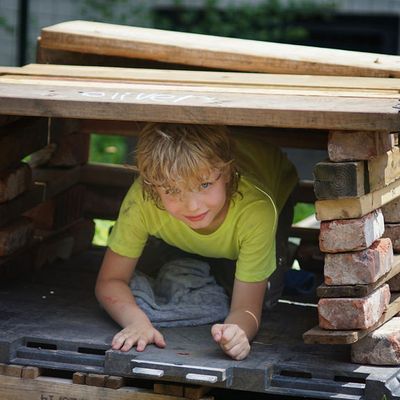
It’s easy to overgeneralize about parenting in 2016. Oftentimes, the trend- and think pieces written about “parenting” are really referring to how privileged people parent. Still, it’s safe to say that middle-class-and-richer parents these days do seem to be taking a rather overprotective approach. There’s a reason “helicopter parenting” is a term — it’s viewed as less and less acceptable to leave kids alone, to give them unstructured time in which to play and explore on their own terms. Overscheduling is in.
It wasn’t always this way. “Parents used to let elementary school-age kids play in the park with friends and siblings unsupervised, but they increasingly don’t let their progeny out of their sight until adolescence,” writes Ben Adler in Grist. “In some suburbs, parents can actually have their 10-year-old taken away by the government if the child is allowed to walk to a park unaccompanied.”
Adler has a nice story about a playground on Governors Island — which is just south of Manhattan in New York Harbor, and accessible by ferry — called play:groundNYC, which embraces a very different philosophy. When Adler first approached the playground on one of his reporting trips there, he was told by a security guard, “It’s more of a junkyard.” After parents sign a waiver, their kids are let loose on a small field full of “the detritus of New York’s consumer culture, including, on my visit, tires, a plastic water cooler, pieces of wood in all sorts of sizes and shapes, a stroller, and a stationary exercise bike,” where they do what kids have done forever: figure out how to have fun and make (and break) stuff. There are no parents allowed on play:groundNYC itself, but there are “playworkers” to help guide and keep an eye on the kids. Given all the junk lying around for the kids to play with, it’s inevitable that they will occasionally get dirty and scuffed up and scratched. In fact, that’s kind of the point.
As Adler notes, this isn’t just a refreshing departure from an annoying and seemingly growing cultural norm — it’s also an idea that some developmental psychologists and educators are into:
Ellen Sandseter, a professor of early-childhood education at Queen Maud University College in Norway, published a paper in 2011, based on her observations and interviews on playgrounds, touting the “the anti-phobic effects of thrilling experiences” in children’s play. She found that children benefit from, if not actual danger, the feeling of danger and related sensations that result from activities like climbing up to get a bird’s-eye view, playing with dangerous tools, or exploring on their own. “Our fear of children being harmed may result in more fearful children and increased levels of psychopathology,” she writes.
It makes a lot of sense to think that kids benefit from being placed in environments in which they are able to explore on their own, to make mistakes and to figure out how to get the most out of the world around them. Hopefully this trend of so-called “adventure playgrounds” will catch on — at the moment, Adler notes, there “are about a half-dozen in the United States, with twice as many in the pipeline.”




